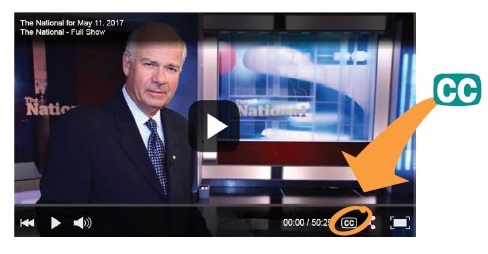Internet Accessibility
More Canadians than ever are accessing news, information and entertainment media through the internet than ever before, and the trend of ‘cutting cable’ is becoming an increasingly popular way to save on utility expenses while still enjoying the television programming available through cable and satellite providers. Similarly, many Canadians enjoy listening to their favorite radio programs on their mobile device or computer. Despite these changes in the devices used to access television and radio programming, the need for accessible content has not changed.
This section of the CHHA-BAF website will examine accessibility features available in online Video Streaming platforms, Radio and Podcast forums, and website accessibility.
Video Streaming Accessibility
Video streaming is becoming an increasingly popular venue to access TV shows, movies and documentaries – companies such as Netflix, Hulu, Roku, Android Box, and others have integrated closed captioning into their program services.
However, there are still gaps in services throughout the vast array of websites, groups and downloading sites. In some cases, there may be no captioning option available, in others, the captioning is computer generated and of poor quality.
In Canada, the CRTC does not currently regulate web based broadcasting. However, but there is a policy in place that requires broadcasters that air content over a regulated distribution system (such as traditional television broadcasting), to ensure the content is distributed captioned over non-regulated sources, such as their website. For example, the CBC offers online streaming of their televised programs with captioning.
 Closed Captioning function on an online streaming platform
Closed Captioning function on an online streaming platform
For a non-exhaustive list of some of the most popular online streaming providers, and how to access the captioning function on their video player please refer to the booklet “Full Access: A Guide for Broadcasting Accessibility for Canadians living with hearing loss”
Audio Accessibility
Online radio podcasts and radio station websites also vary in the availability of accessibility options and the availability of transcripts for previously broadcast shows.
Radio stations that offer transcripts for shows aired through AM or FM broadcasts, may also provide transcripts for the online version of these shows made available through podcasts. Transcripts of these shows may only be available upon request once the program is finished, and are generally limited to talk shows. The CBC offers transcripts online for some non-music based programs, such as The Current.
While the availability of transcripts is limited, online radio shows and podcasts can offer some accessibility through their audio media player. While the features available on an online media player depends on the station providing this service, most media players allow the listener to adjust the volume, stop, rewind and replay the program. This can be helpful to those living with hearing loss if certain words or parts of the dialogue are missed when listening to the recording the first time.
For more information regarding Audio Accessibility, please refer to the booklet “Full Access: A Guide for Broadcasting Accessibility for Canadians living with hearing loss”
Website Accessibility
Website accessibility is now a mainstream issue, and many website developers follow guidelines to design their websites.
The World Wide Web Consortium or W3C, has developed a set of international guidelines to aid in the continued expansion and development of the web, and provides accessibility standards and testing tools to aid in the development of accessible websites.
In Canada, there are three standards regulating web accessibility for government websites: The Standard on Optimizing Websites and Applications for Mobile Devices, the Standard on Web Usability and the Standard on Web Interoperability. The Government of Canada has also developed the Web Experience Toolkit (WET), a set of web components for building innovative websites available openly for anyone who wishes to develop accessible websites using this framework.
Knowing a few tricks can help navigating any website easier for consumers:
For most web browsers (such as Google Chrome, Microsoft Edge, and others), the text can be magnified if it automatically displays in a font that is too small to be easily read. Press the CTRL key and tap the + key at the same time to increase the text size (holding the CTRL key and tapping the – key at the same time reduces the text size).
If the colours used on a website do not have enough contrast for the text to be easily read or they are distracting, this can be adjusted:
For Internet Explorer:
- Select the Tools menu (Shortcut: Shortcut: ALT + O).
- Select Internet Options (Shortcut: O).
- Select the Colours button that is in the bottom left-hand corner (Shortcut: ALT + O).
- Ensure the Use Windows colours check box is not selected (Shortcut: ALT + W to toggle on/off).
- Choose your desired colours by selecting the colour box and then choosing from the available colours. You can change the colours for text, background, visited and unvisited hyperlinks and hover.
- Select OK on the ‘Colours’ screen.
- Select OK on the ‘Internet Options’ screen.
For Google Chrome:
- The Google Chrome extension Change Colour can override styles permanently. When the extension is installed, a new icon in the Chrome address bar will appear.
- Click the icon to display three options: the extension can apply to an individual active page, the domain, or all websites that visited.
- More accessibility extensions (such as contrast enhancers, Image Alt Text Viewer, and others) can be found through Chrome Accessibility
BBC’s My web, My Way provides tools and information to assist people with a disability to get the most out of the Internet. Includes practical how-to articles for Windows, Mac and Linux.
